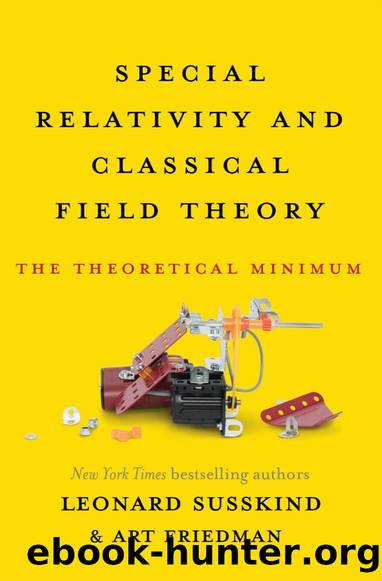Special Relativity and Classical Field Theory: The Theoretical Minimum by Leonard Susskind

Author:Leonard Susskind [Susskind, Leonard]
Language: eng
Format: epub
ISBN: 9780465093359
Google: ukjTDQAAQBAJ
Barnesnoble:
Publisher: Basic Books
Published: 2017-09-26T00:00:00+00:00
Of all the fundamental forces in nature, and there are many of them, few were known before the 1930s. Most are deeply hidden in the microscopic quantum world and only became observable with the advent of modern elementary particle physics. Most of the fundamental forces are what physicists call short-range. This means that they act only on objects that are separated by very small distances. The influence of a short-range force decreases so rapidly when the objects are separated that, for the most part, they are not noticed in the ordinary world. An example is the so-called nuclear force between nucleons (protons and neutrons). Itâs a powerful force whose role is to bind these particles into nuclei. But as powerful as that force is, we donât ordinarily notice it. The reason is that its effects disappear exponentially when the nucleons are separated by more than about 10â15 meters. The forces that we do notice are the long-range forces whose effects fade slowly with distance.
Of all the forces of nature, only three were known to the ancientsâelectric, magnetic, and gravitational. Thales of Miletos (600 BC) was said to have moved feathers with amber that had been rubbed with cat fur. At about the same time he mentioned lodestone, a naturally occurring magnetic material. Aristotle, who was probably late on the scene, had a theory of gravity, even if it was completely wrong. These three were the only forces that were known until the 1930s.
What makes these easily observed forces special is that they are long-range. Long-range forces fade slowly with distance and can be seen between objects when they are well separated.
Gravitational force is by far the most obvious of the three, but surprisingly it is much weaker than electromagnetic force. The reason is interesting and worth a short digression. It goes back to Newtonâs universal law of gravitational attraction: Everything attracts everything else. Every elementary particle in your body is attracted by every particle in the Earth. Thatâs a lot of particles, all attracting one another, and the result is a significant and noticeable gravitational attraction, but in fact the gravitational attraction between individual particles is far too small to measure.
The electric forces between charged particles is many orders of magnitude stronger than the gravitational force. But unlike gravity, electric force can be either attractive (between opposite charges) or repulsive (between like charges). Both you and the Earth are composed of an equal number of positive charges (protons) and negative charges (electrons), and the result is that the forces cancel. If we imagined getting rid of all the electrons in both you and the Earth, the repulsive electric forces would easily overwhelm gravity and blast you from the Earthâs surface. In fact, it would be enough to blast the Earth and you into smithereens.
In any case, gravity is not the subject of these lectures, and the only other long-range forces are electromagnetic. Electric and magnetic forces are closely related to each other; in a sense they are a single thing, and the unifying link is relativity.
Download
This site does not store any files on its server. We only index and link to content provided by other sites. Please contact the content providers to delete copyright contents if any and email us, we'll remove relevant links or contents immediately.
The Complete Stick Figure Physics Tutorials by Allen Sarah(7338)
Secrets of Antigravity Propulsion: Tesla, UFOs, and Classified Aerospace Technology by Ph.D. Paul A. Laviolette(5333)
Thing Explainer by Randall Munroe(3910)
The River of Consciousness by Oliver Sacks(3572)
The Order of Time by Carlo Rovelli(3162)
How To by Randall Munroe(3074)
A Brief History of Time by Stephen Hawking(2992)
I Live in the Future & Here's How It Works by Nick Bilton(2960)
What If?: Serious Scientific Answers to Absurd Hypothetical Questions by Randall Munroe(2668)
The Great Unknown by Marcus du Sautoy(2662)
Midnight in Chernobyl by Adam Higginbotham(2516)
Blockchain: Ultimate Step By Step Guide To Understanding Blockchain Technology, Bitcoin Creation, and the future of Money (Novice to Expert) by Keizer Söze(2467)
Networks: An Introduction by Newman Mark(2382)
The Meaning of it All by Richard Feynman(2319)
Easy Electronics by Charles Platt(2308)
The Tao of Physics by Fritjof Capra(2247)
Midnight in Chernobyl: The Untold Story of the World's Greatest Nuclear Disaster by Adam Higginbotham(2196)
When by Daniel H Pink(2098)
Introducing Relativity by Bruce Bassett(2097)
